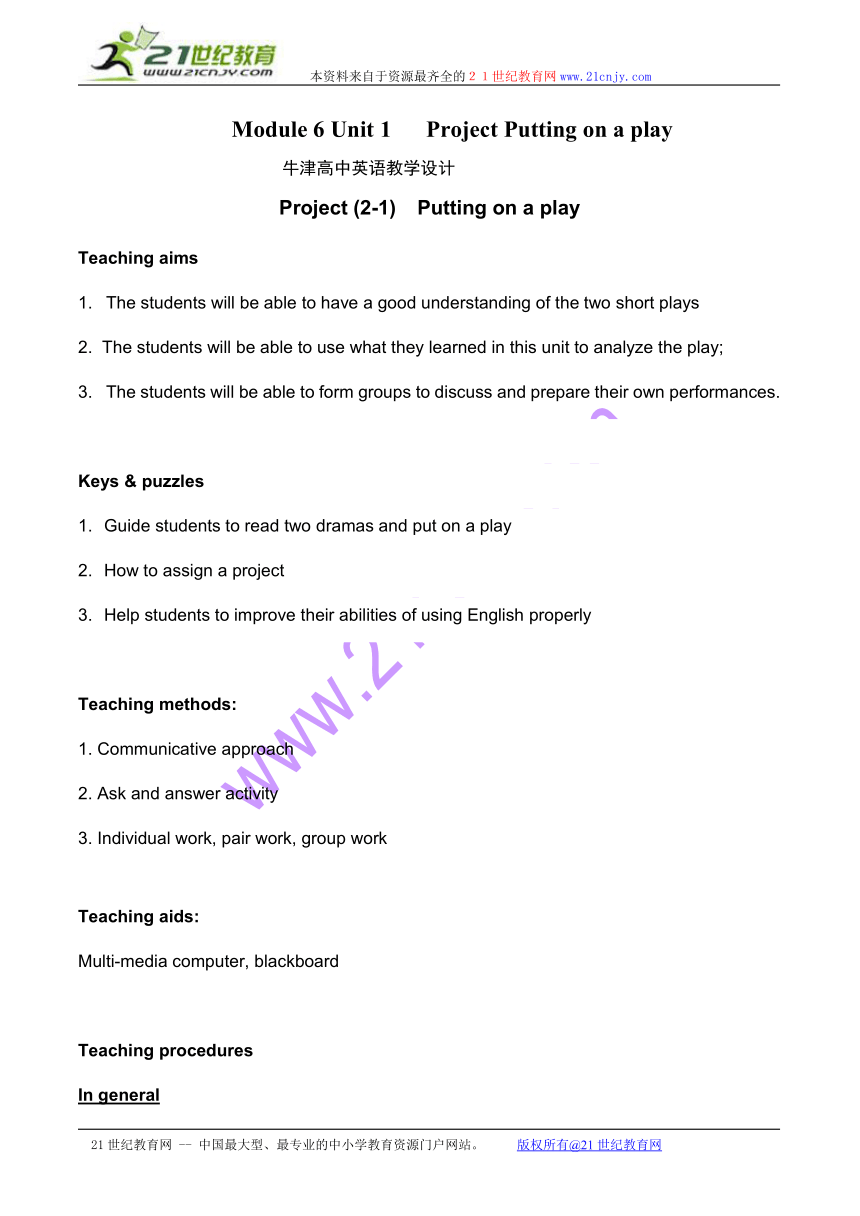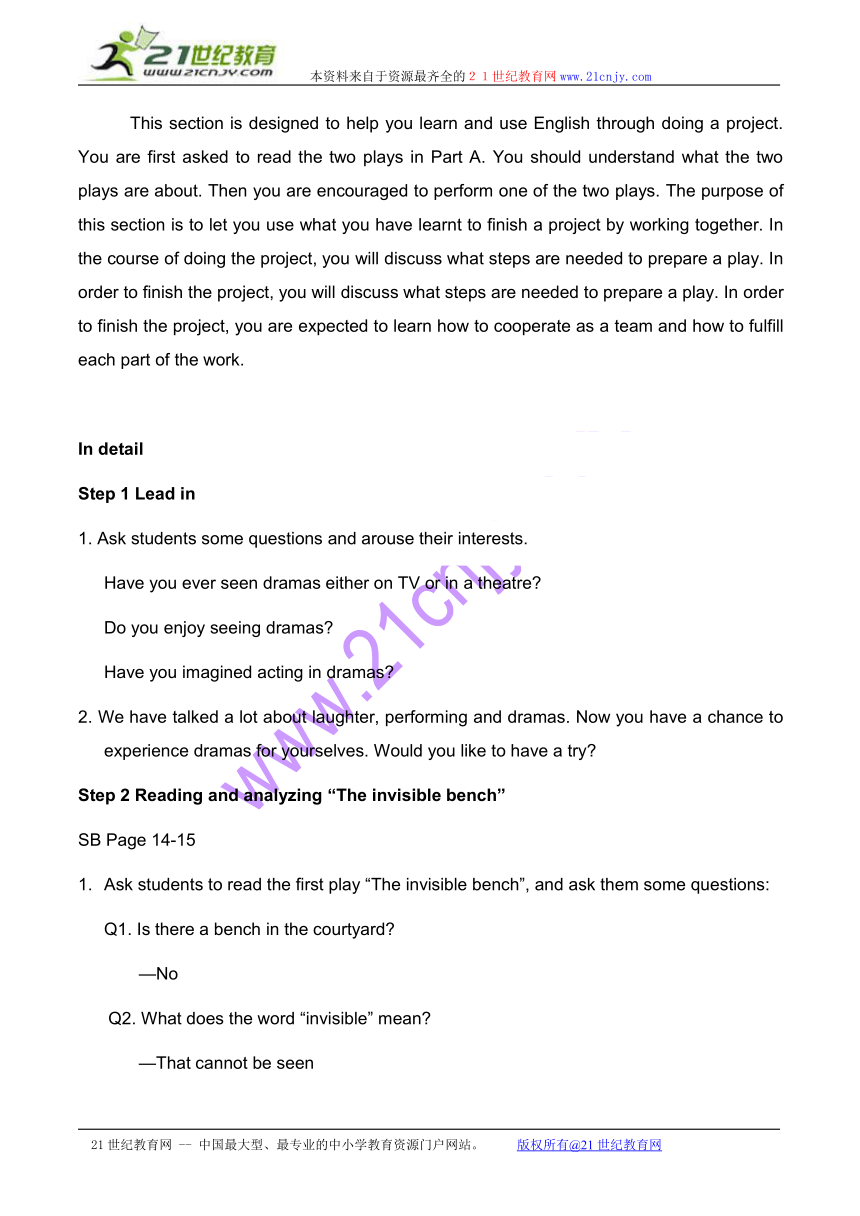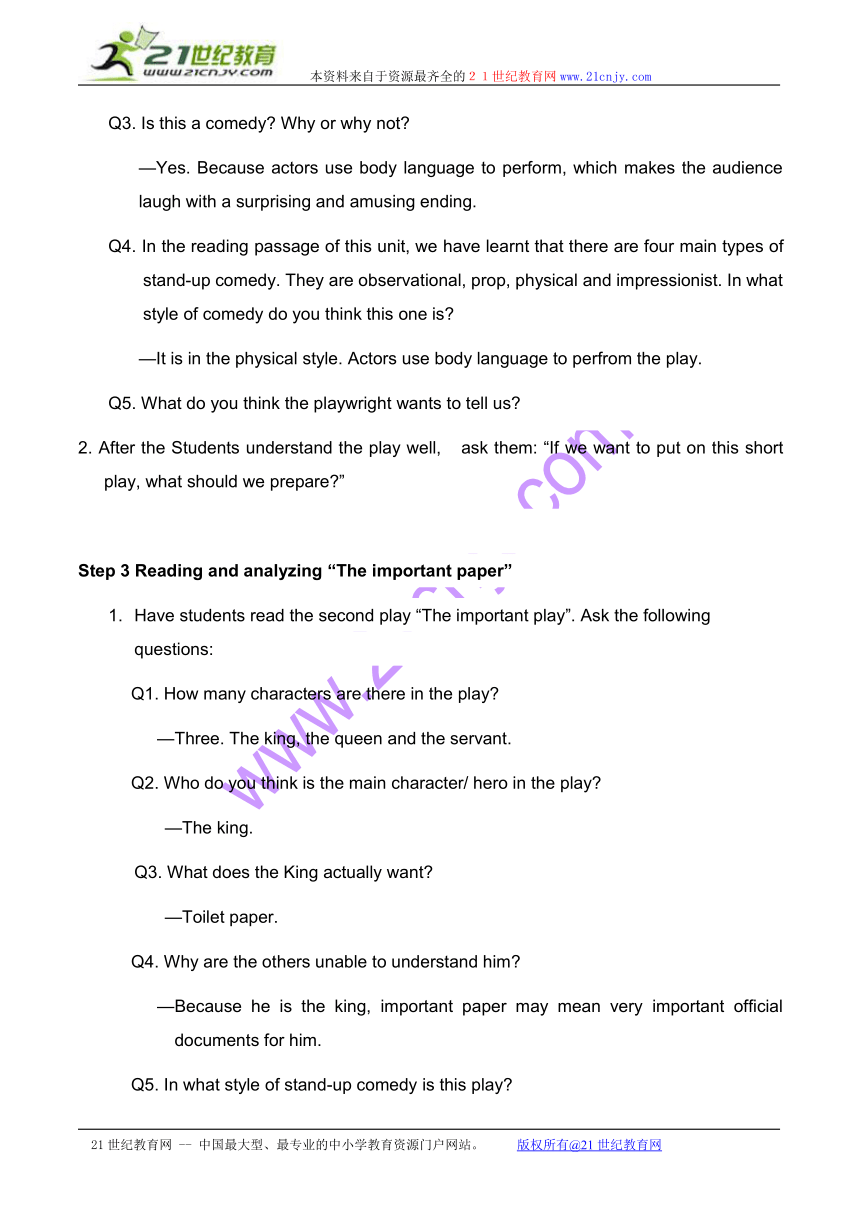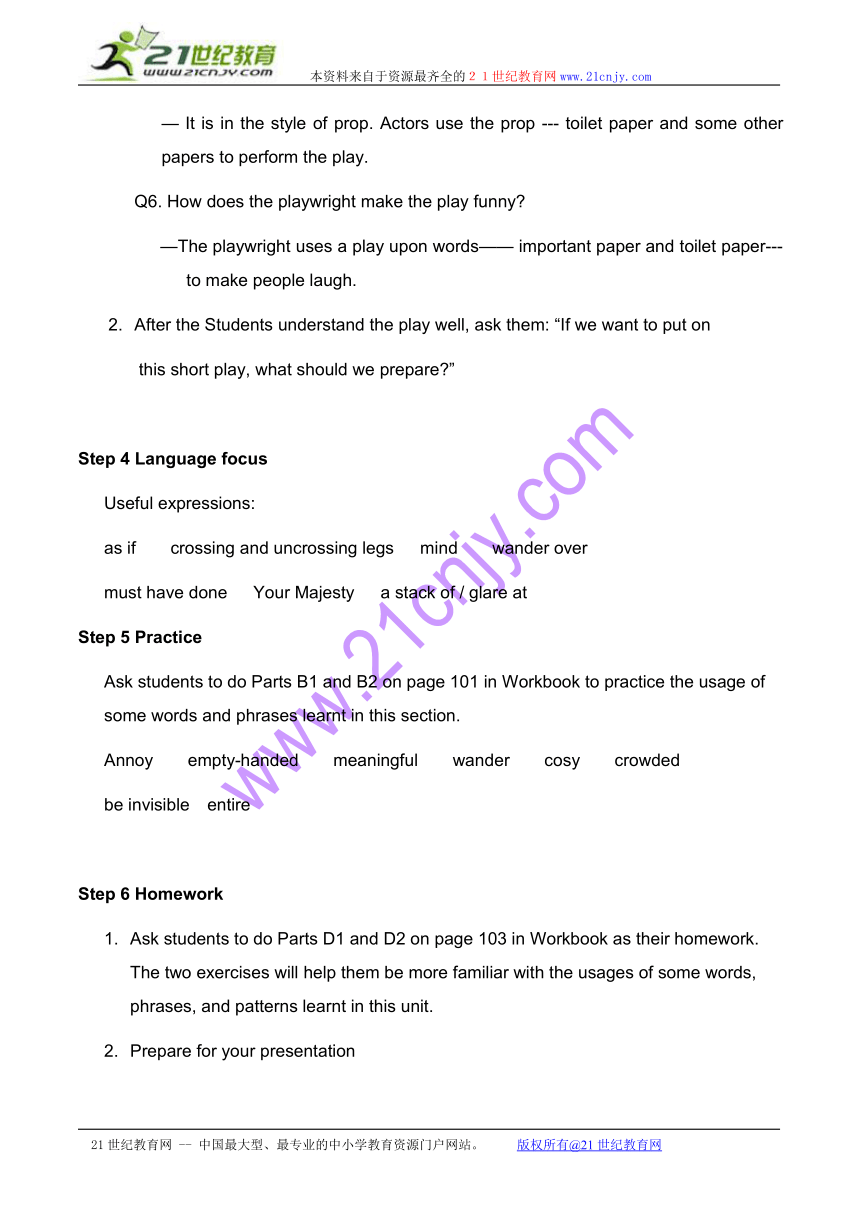Module 6 Unit 1 Laughter is good for you 教案
文档属性
| 名称 | Module 6 Unit 1 Laughter is good for you 教案 |  | |
| 格式 | rar | ||
| 文件大小 | 16.0KB | ||
| 资源类型 | 教案 | ||
| 版本资源 | 牛津译林版 | ||
| 科目 | 英语 | ||
| 更新时间 | 2010-07-29 11:23:00 | ||
图片预览




文档简介
本资料来自于资源最齐全的21世纪教育网www.21cnjy.com
Module 6 Unit 1 Project Putting on a play
牛津高中英语教学设计
Project (2-1) Putting on a play
Teaching aims
1. The students will be able to have a good understanding of the two short plays
2. The students will be able to use what they learned in this unit to analyze the play;
3. The students will be able to form groups to discuss and prepare their own performances.
Keys & puzzles
1. Guide students to read two dramas and put on a play
2. How to assign a project
3. Help students to improve their abilities of using English properly
Teaching methods:
1. Communicative approach
2. Ask and answer activity
3. Individual work, pair work, group work
Teaching aids:
Multi-media computer, blackboard
Teaching procedures
In general
This section is designed to help you learn and use English through doing a project. You are first asked to read the two plays in Part A. You should understand what the two plays are about. Then you are encouraged to perform one of the two plays. The purpose of this section is to let you use what you have learnt to finish a project by working together. In the course of doing the project, you will discuss what steps are needed to prepare a play. In order to finish the project, you will discuss what steps are needed to prepare a play. In order to finish the project, you are expected to learn how to cooperate as a team and how to fulfill each part of the work.
In detail
Step 1 Lead in
1. Ask students some questions and arouse their interests.
Have you ever seen dramas either on TV or in a theatre
Do you enjoy seeing dramas
Have you imagined acting in dramas
2. We have talked a lot about laughter, performing and dramas. Now you have a chance to experience dramas for yourselves. Would you like to have a try
Step 2 Reading and analyzing “The invisible bench”
SB Page 14-15
1. Ask students to read the first play “The invisible bench”, and ask them some questions:
Q1. Is there a bench in the courtyard
—No
Q2. What does the word “invisible” mean
—That cannot be seen
Q3. Is this a comedy Why or why not
—Yes. Because actors use body language to perform, which makes the audience laugh with a surprising and amusing ending.
Q4. In the reading passage of this unit, we have learnt that there are four main types of stand-up comedy. They are observational, prop, physical and impressionist. In what style of comedy do you think this one is
—It is in the physical style. Actors use body language to perfrom the play.
Q5. What do you think the playwright wants to tell us
2. After the Students understand the play well, ask them: “If we want to put on this short play, what should we prepare ”
Step 3 Reading and analyzing “The important paper”
1. Have students read the second play “The important play”. Ask the following questions:
Q1. How many characters are there in the play
—Three. The king, the queen and the servant.
Q2. Who do you think is the main character/ hero in the play
—The king.
Q3. What does the King actually want
—Toilet paper.
Q4. Why are the others unable to understand him
—Because he is the king, important paper may mean very important official documents for him.
Q5. In what style of stand-up comedy is this play
— It is in the style of prop. Actors use the prop --- toilet paper and some other papers to perform the play.
Q6. How does the playwright make the play funny
—The playwright uses a play upon words—— important paper and toilet paper--- to make people laugh.
2. After the Students understand the play well, ask them: “If we want to put on
this short play, what should we prepare ”
Step 4 Language focus
Useful expressions:
as if crossing and uncrossing legs mind wander over
must have done Your Majesty a stack of / glare at
Step 5 Practice
Ask students to do Parts B1 and B2 on page 101 in Workbook to practice the usage of some words and phrases learnt in this section.
Annoy empty-handed meaningful wander cosy crowded
be invisible entire
Step 6 Homework
1. Ask students to do Parts D1 and D2 on page 103 in Workbook as their homework. The two exercises will help them be more familiar with the usages of some words, phrases, and patterns learnt in this unit.
2. Prepare for your presentation
Project (2-2) Putting on a play
Teaching procedures
In detail
Step 1 lead-in:
Teacher shows students the rules of how to present.
* Planning
* Preparing
* Producing
* Presenting
Step 2 Planning:
1. Ask students to work in groups of five or six. Have them discuss the eight questions given in this part on page 15.
Q1. What kind of comedy do these two plays use
Q2. Do you think these plays are funny Why
Q3. Which play will you use
Q4. Who will play each character Who will be the director
Q5. What kind of scenery will you need Who will make it
Q6. Will you need props Who will find them
Q7. Will you need costumes Who will make them
Q8. Where and how often will you practice
2. Students may make a flow chart to help them manage the task.
Step 3 Preparing:
(1). Actors and actresses should recite all their lines.
(2). All props needed should be found.
(3). All costumes needed should be made.
(4). Director should be in charge of all things related to the play.
Step 4 Producing:
They need to practice the play before they perform it in the class.
Step 5 Presenting:
Have each group perform the play. After all the groups have performed their plays, ask students to:
decide which group’s performance is the best.
decide who is the best actor and actress.
decide who is the best director.
decide which group’s props and costumes are the best.
Step 6 Awards:
Teacher may make some comments on their performance, and also invites the students to talk about which they like best, and why.
Awards will be given to the best ones.
Step 7 Homework:
1. Ask students to first read the article in Part A on page 107 in Workbook, and then write a summary.
2. Review the whole unit.
Feedback
Mine
Students are very interested in the task. They all want to perform the role very well. They actively took part in the discussion and showed great interest in their own roles. However, some groups are still held with confusion about how to perform every role. Fortunately, they have enough time to think it over and practice the play before they perform it in the class. Although they don’t know who will be the best, they are still excited about the task.
Yours
21世纪教育网 -- 中国最大型、最专业的中小学教育资源门户网站。 版权所有@21世纪教育网
Module 6 Unit 1 Project Putting on a play
牛津高中英语教学设计
Project (2-1) Putting on a play
Teaching aims
1. The students will be able to have a good understanding of the two short plays
2. The students will be able to use what they learned in this unit to analyze the play;
3. The students will be able to form groups to discuss and prepare their own performances.
Keys & puzzles
1. Guide students to read two dramas and put on a play
2. How to assign a project
3. Help students to improve their abilities of using English properly
Teaching methods:
1. Communicative approach
2. Ask and answer activity
3. Individual work, pair work, group work
Teaching aids:
Multi-media computer, blackboard
Teaching procedures
In general
This section is designed to help you learn and use English through doing a project. You are first asked to read the two plays in Part A. You should understand what the two plays are about. Then you are encouraged to perform one of the two plays. The purpose of this section is to let you use what you have learnt to finish a project by working together. In the course of doing the project, you will discuss what steps are needed to prepare a play. In order to finish the project, you will discuss what steps are needed to prepare a play. In order to finish the project, you are expected to learn how to cooperate as a team and how to fulfill each part of the work.
In detail
Step 1 Lead in
1. Ask students some questions and arouse their interests.
Have you ever seen dramas either on TV or in a theatre
Do you enjoy seeing dramas
Have you imagined acting in dramas
2. We have talked a lot about laughter, performing and dramas. Now you have a chance to experience dramas for yourselves. Would you like to have a try
Step 2 Reading and analyzing “The invisible bench”
SB Page 14-15
1. Ask students to read the first play “The invisible bench”, and ask them some questions:
Q1. Is there a bench in the courtyard
—No
Q2. What does the word “invisible” mean
—That cannot be seen
Q3. Is this a comedy Why or why not
—Yes. Because actors use body language to perform, which makes the audience laugh with a surprising and amusing ending.
Q4. In the reading passage of this unit, we have learnt that there are four main types of stand-up comedy. They are observational, prop, physical and impressionist. In what style of comedy do you think this one is
—It is in the physical style. Actors use body language to perfrom the play.
Q5. What do you think the playwright wants to tell us
2. After the Students understand the play well, ask them: “If we want to put on this short play, what should we prepare ”
Step 3 Reading and analyzing “The important paper”
1. Have students read the second play “The important play”. Ask the following questions:
Q1. How many characters are there in the play
—Three. The king, the queen and the servant.
Q2. Who do you think is the main character/ hero in the play
—The king.
Q3. What does the King actually want
—Toilet paper.
Q4. Why are the others unable to understand him
—Because he is the king, important paper may mean very important official documents for him.
Q5. In what style of stand-up comedy is this play
— It is in the style of prop. Actors use the prop --- toilet paper and some other papers to perform the play.
Q6. How does the playwright make the play funny
—The playwright uses a play upon words—— important paper and toilet paper--- to make people laugh.
2. After the Students understand the play well, ask them: “If we want to put on
this short play, what should we prepare ”
Step 4 Language focus
Useful expressions:
as if crossing and uncrossing legs mind wander over
must have done Your Majesty a stack of / glare at
Step 5 Practice
Ask students to do Parts B1 and B2 on page 101 in Workbook to practice the usage of some words and phrases learnt in this section.
Annoy empty-handed meaningful wander cosy crowded
be invisible entire
Step 6 Homework
1. Ask students to do Parts D1 and D2 on page 103 in Workbook as their homework. The two exercises will help them be more familiar with the usages of some words, phrases, and patterns learnt in this unit.
2. Prepare for your presentation
Project (2-2) Putting on a play
Teaching procedures
In detail
Step 1 lead-in:
Teacher shows students the rules of how to present.
* Planning
* Preparing
* Producing
* Presenting
Step 2 Planning:
1. Ask students to work in groups of five or six. Have them discuss the eight questions given in this part on page 15.
Q1. What kind of comedy do these two plays use
Q2. Do you think these plays are funny Why
Q3. Which play will you use
Q4. Who will play each character Who will be the director
Q5. What kind of scenery will you need Who will make it
Q6. Will you need props Who will find them
Q7. Will you need costumes Who will make them
Q8. Where and how often will you practice
2. Students may make a flow chart to help them manage the task.
Step 3 Preparing:
(1). Actors and actresses should recite all their lines.
(2). All props needed should be found.
(3). All costumes needed should be made.
(4). Director should be in charge of all things related to the play.
Step 4 Producing:
They need to practice the play before they perform it in the class.
Step 5 Presenting:
Have each group perform the play. After all the groups have performed their plays, ask students to:
decide which group’s performance is the best.
decide who is the best actor and actress.
decide who is the best director.
decide which group’s props and costumes are the best.
Step 6 Awards:
Teacher may make some comments on their performance, and also invites the students to talk about which they like best, and why.
Awards will be given to the best ones.
Step 7 Homework:
1. Ask students to first read the article in Part A on page 107 in Workbook, and then write a summary.
2. Review the whole unit.
Feedback
Mine
Students are very interested in the task. They all want to perform the role very well. They actively took part in the discussion and showed great interest in their own roles. However, some groups are still held with confusion about how to perform every role. Fortunately, they have enough time to think it over and practice the play before they perform it in the class. Although they don’t know who will be the best, they are still excited about the task.
Yours
21世纪教育网 -- 中国最大型、最专业的中小学教育资源门户网站。 版权所有@21世纪教育网
